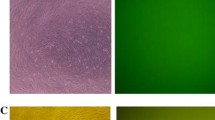Abstract
Transgenic promoter systems are of great interest for their potential use in gene therapy or production due to their high activity, long term, and cell specificity. Here, in order to obtain promoters with high activity and expressed specifically in skeletal muscle, the MYOD1, MYF5, and MCK were selected as the candidate genes. The truncated promoters were amplified and their activity was verified through dual-luciferase reporter gene test. We used genetic engineering techniques to improve promoter activity by tandemly linking enhancers and promoters or two promoters. Furthermore, synthetic promoter was the most active when two eMCK enhancers and pMCK promoter were cascaded. To improve the tissue specificity of the promoter, the seed region of translational repressor miR-208a was inserted into the downstream of the promoter (pGL3-2eMCK-pMCK-T208-mCherry-EGFP). The results showed that the expression level of target genes decreased significantly (P < 0.05) in myocardium rather than in skeletal muscle. The results of in vivo transfection indicated that tandem transcriptional regulatory elements can increase promoter activity in mice. This work laid the foundation for future research on genetically modified pigs.



Similar content being viewed by others
References
Zhang, D., Zhang, Z., Unver, T., & Zhang, B. (2021). CRISPR/Cas: A powerful tool for gene function study and crop improvement. Journal of Advanced Research, 29, 207–221.
Sledzinski, P., Dabrowska, M., Nowaczyk, M., & Olejniczak, M. (2021). Paving the way towards precise and safe CRISPR genome editing. Biotechnology Advances, 49, 107737.
Sah, S. K., Kaur, G., & Wani, S. H. (2016). Metabolic engineering of compatible solute trehalose for abiotic stress tolerance in plants. Osmolytes and plants acclimation to changing environment: Emerging omics technologies, (pp. 83-96).
Wall, R. J., Powell, A. M., Paape, M. J., Kerr, D. E., Bannerman, D. D., Pursel, V. G., Wells, K. D., Talbot, N., & Hawk, H. W. (2005). Genetically enhanced cows resist intramammary Staphylococcus aureus infection. Nature Biotechnology, 23, 445–451.
Zhou, Y., Lin, Y., Wu, X., Feng, C., Long, C., Xiong, F., Wang, N., Pan, D., & Chen, H. (2014). The high-level accumulation of n-3 polyunsaturated fatty acids in transgenic pigs harboring the n-3 fatty acid desaturase gene from Caenorhabditis briggsae. Transgenic Research, 23, 89–97.
Maeng, G., Das, S., Greising, S. M., Gong, W., Singh, B. N., Kren, S., Mickelson, D., Skie, E., Gafni, O., Sorensen, J. R., et al. (2021). Humanized skeletal muscle in MYF5/MYOD/MYF6-null pig embryos. Nature Biomedical Engineering, 19, 1–10.
Anguita-Ruiz, A., Bustos-Aibar, M., Plaza-Díaz, J., Mendez-Gutierrez, A., Alcalá-Fdez, J., Aguilera, C. M., & Ruiz-Ojeda, F. J. (2021). Omics approaches in adipose tissue and skeletal muscle addressing the role of extracellular matrix in obesity and metabolic dysfunction. International journal of molecular sciences, 22(5), 2756.
Che, J., Xu, C., Wu, Y., Jia, P., Han, Q., Ma, Y., Wang, X., Du, Y., & Zheng, Y. (2021). Early-senescent bone marrow mesenchymal stem cells promote C2C12 cell myogenic differentiation by preventing the nuclear translocation of FOXO3. Life Science, 277, 119520.
Liu, X., Zeng, S., Liu, S., Wang, G., Lai, H., Zhao, X., Bi, S., Guo, D., Chen, X., Yi, H., et al. (2020). Identifying the related genes of muscle growth and exploring the functions by compensatory growth in mandarin fish (Siniperca chuatsi). Frontiers in Physiology, 11, 553563.
Johnson, J. E., Wold, B. J., & Hauschka, S. D. (1989). Muscle creatine kinase sequence elements regulating skeletal and cardiac muscle expression in transgenic mice. Molecular and Cellular Biology, 9, 3393–3399.
Donoviel, D. B., Shield, M. A., Buskin, J. N., Haugen, H. S., Clegg, C. H., & Hauschka, S. D. (1996). Analysis of muscle creatine kinase gene regulatory elements in skeletal and cardiac muscles of transgenic mice. Molecular and Cellular Biology, 16, 1649–1658.
Zavaljevski, M., Himeda, C., Tai, P., Nishiuchi, E., Gregorevic, P., Allen, J., Finn, E., Nguyen, Q., Blankinship, M., Meuse, L., et al. (2007). Design of tissue-specific regulatory cassettes for high-level rAAV-mediated expression in skeletal and cardiac muscle. Molecular Therapy, 15, 320–329.
Baskerville, S., & Bartel, D. P. (2005). Microarray profiling of microRNAs reveals frequent coexpression with neighboring miRNAs and host genes. RNA, 11, 241–247.
Barad, O., Meiri, E., Avniel, A., Aharonov, R., Barzilai, A., Bentwich, I., Einav, U., Gilad, S., Hurban, P., Karov, Y., et al. (2004). MicroRNA expression detected by oligonucleotide microarrays: System establishment and expression profiling in human tissues. Genome Research, 14, 2486–2494.
Montgomery, R. L., Hullinger, T. G., Semus, H. M., Dickinson, B. A., Seto, A. G., Lynch, J. M., Stack, C., Latimer, P. A., Olson, E. N., & van Rooij, E. (2011). Therapeutic inhibition of miR-208a improves cardiac function and survival during heart failure. Circulation, 124, 1537–1547.
van Rooij, E., Sutherland, L. B., Qi, X., Richardson, J. A., Hill, J., & Olson, E. N. (2007). Control of stress-dependent cardiac growth and gene expression by a MicroRNA. Science, 316, 575.
Lagos-Quintana, M. (2003). New microRNAs from mouse and human. RNA, 9, 175–179.
Callis, T. E., Pandya, K., Seok, H. Y., Tang, R.-H., Tatsuguchi, M., Huang, Z.-P., Chen, J.-F., Deng, Z., Gunn, B., Shumate, J., et al. (2009). MicroRNA-208a is a regulator of cardiac hypertrophy and conduction in mice. The Journal of Clinical Investigation, 119, 2772–2786.
van Rooij, E., Quiat, D., Johnson, B. A., Sutherland, L. B., Qi, X., Richardson, J. A., Kelm, R. J., & Olson, E. N. (2009). A family of microRNAs encoded by myosin genes governs myosin expression and muscle performance. Developmental Cell, 17, 662–673.
Pan, Y., Geng, R., Zhou, N., Zheng, G. F., Zhao, H., Wang, J., Zhao, C. M., Qiu, X. B., Yang, Y. Q., & Liu, X. Y. (2015). TBX20 loss-of-function mutation contributes to double outlet right ventricle. International Journal of Molecular Medicine, 35, 1058–1066.
Maak, S., Neumann, K., & Swalve, H. H. (2006). Identification and analysis of putative regulatory sequences for the MYF5/MYF6 locus in different vertebrate species. Gene, 379, 141–147.
Öztürk, S., Ergün, B. G., & Çalık, P. (2017). Double promoter expression systems for recombinant protein production by industrial microorganisms. Applied Microbiology and Biotechnology, 101, 7459–7475.
Salva, M. Z., Himeda, C. L., Tai, P. W. L., Nishiuchi, E., Gregorevic, P., Allen, J. M., Finn, E. E., Nguyen, Q. G., Blankinship, M. J., Meuse, L., et al. (2007). Design of tissue-specific regulatory cassettes for high-level rAAV-mediated expression in skeletal and cardiac muscle. Molecular Therapy, 15, 320–329.
Gurr, S. J., & Rushton, P. J. (2005). Engineering plants with increased disease resistance: How are we going to express it? Trends in Biotechnology, 23, 283–290.
Sahoo, D. K., Sarkar, S., Raha, S., Maiti, I. B., & Dey, N. (2014). Comparative analysis of synthetic DNA promoters for high-level gene expression in plants. Planta, 240, 855–875.
Wu, C. Y., Suzuki, A., Washida, H., & Takaiwa, F. (1998). The GCN4 motif in a rice glutelin gene is essential for endosperm-specific gene expression and is activated by Opaque-2 in transgenic rice plants. The Plant Journal, 14, 673–683.
Sawant, S. V., Kiran, K., Mehrotra, R., Chaturvedi, C. P., Ansari, S. A., Singh, P., Lodhi, N., & Tuli, R. (2005). A variety of synergistic and antagonistic interactions mediated by cis-acting DNA motifs regulate gene expression in plant cells and modulate stability of the transcription complex formed on a basal promoter. Journal of Experimental Botany, 56, 2345–2353.
Rushton, P. J., Reinstädler, A., Lipka, V., Lippok, B., & Somssich, I. E. (2002). Synthetic plant promoters containing defined regulatory elements provide novel insights into pathogen- and wound-induced signaling. The Plant Cell, 14, 749.
Venter, M. (2007). Synthetic promoters: Genetic control through cis engineering. Trends in Plant Science, 12, 118–124.
Blackwood, E. M. (1998). Going the distance: A current view of enhancer action. Science, 281, 60–63.
Liu, Z., Zheng, W., Ge, C., Cui, W., Zhou, L., & Zhou, Z. (2019). High-level extracellular production of recombinant nattokinase in Bacillus subtilis WB800 by multiple tandem promoters. BMC Microbiology, 19, 89.
Blazeck, J., Garg, R., Reed, B., & Alper, H. S. (2012). Controlling promoter strength and regulation in Saccharomyces cerevisiae using synthetic hybrid promoters. Biotechnology and Bioengineering, 109, 2884–2895.
Acknowledgements
We thank Prof. Dequan Xu for the expression plasmids.
Funding
This work was supported by the National Major Project of Transgenic Pig [Grant No. 2016ZX08006002].
Author information
Authors and Affiliations
Contributions
All authors contributed to the study conception and design. Material preparation, data collection, and analysis were performed by [XZ] and [ZR]. The first draft of the manuscript was written by [PZ] and all authors commented on previous versions of the manuscript. All authors read and approved the final manuscript.
Corresponding author
Ethics declarations
Conflict of interest
The authors declare no conflict of interest.
Ethical Approval
[HZAUMU2013-0005].
Additional information
Publisher's Note
Springer Nature remains neutral with regard to jurisdictional claims in published maps and institutional affiliations.
Supplementary Information
Below is the link to the electronic supplementary material.
Rights and permissions
About this article
Cite this article
Zuo, X., Zhao, P. & Ren, Z. Construction of a Porcine Skeletal Muscle-Specific Promoter by Inducing the Seed Region of miR-208a. Mol Biotechnol 64, 473–481 (2022). https://doi.org/10.1007/s12033-021-00428-2
Received:
Accepted:
Published:
Issue Date:
DOI: https://doi.org/10.1007/s12033-021-00428-2




